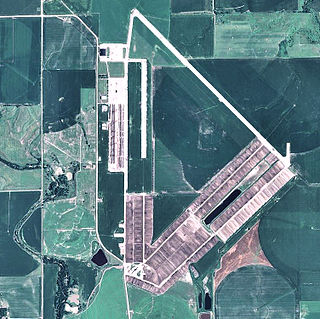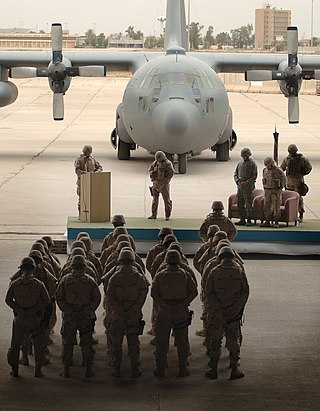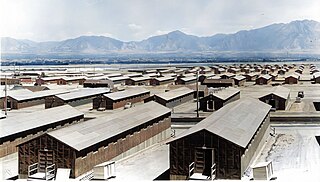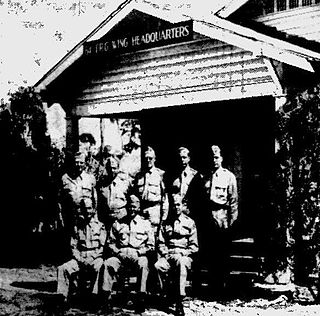
The Second Air Force is a USAF numbered air force responsible for conducting basic military and technical training for Air Force enlisted members and non-flying officers. In World War II the CONUS unit defended the Northwestern United States and Upper Great Plains regions and during the Cold War, was Strategic Air Command unit with strategic bombers and missiles. Elements of Second Air Force engaged in combat operations during the Korean War; Vietnam War, as well as Operation Desert Storm.

Shaw Air Force Base (Shaw AFB) (IATA: SSC, ICAO: KSSC, FAA LID: SSC) is a United States Air Force (USAF) base located approximately 8.4 miles (13.5 km) west-northwest of downtown Sumter, South Carolina. It is one of the largest military bases operated by the United States, and is under the jurisdiction of USAF Air Combat Command (ACC). The 20th Fighter Wing (20th FW) is the host unit.

Air Transport Command (ATC) was a United States Air Force unit that was created during World War II as the strategic airlift component of the United States Army Air Forces.

Chanute Air Force Base is a decommissioned United States Air Force facility, located in Champaign County, Illinois, south of and adjacent to Rantoul, Illinois, about 130 miles (210 km) south of Chicago. Its primary mission throughout its existence was Air Force technical training. Chanute Field was established on 21 May 1917, being one of thirty-two Air Service training camps established after the United States entry into World War I.

Bruning Army Air Field was a flight training installation of the United States Army Air Forces used during World War II and located in northeast Thayer County, Nebraska, at coordinates 40°20'25" North, 97°25'42" West, approximately six miles east of Bruning.

The 370th Air Expeditionary Wing (AEW) is a provisional United States Air Force unit assigned to United States Air Forces Central, which may activate or inactivate it at any time. The unit was last stationed in Iraq, and was likely inactivated in 2011 as part of the United States pullout of forces.
During World War II, the United States Army Air Forces (USAAF) established numerous airfields in California for training pilots and aircrews of USAAF fighters and bombers.

Columbia Army Air Base was a World War II United States Army Air Forces base. It was primarily used for advanced combat training of B-25 Mitchell medium bomber units and replacement pilots.

The III Reconnaissance Command is a disbanded United States Army Air Forces unit. Its last assignment was with Third Air Force stationed at Rapid City Army Air Base, South Dakota, where it was inactivated on 8 April 1946. After transferring to the United States Air Force in September 1947, it was disbanded in October 1948.

Kearns Army Air Base was a U.S. Army Air Base seven miles (11 km) southwest of Salt Lake City, Utah. It served in many roles. Despite being referred to as air base, it had no runways and no airplanes could land near there. It was not associated with Salt Lake City Municipal Airport No. 2, which bordered Kearns to the south, which was a small general aviation airport.

The United States Army Air Forces during World War II had major subordinate Commands below the Air Staff level. These Commands were organized along functional missions. One such Command was the Flying Training Command (FTC). It began as Air Corps Flying Training Command on 23 January 1942, was redesignated Army Air Forces Flying Training Command (AAFTC) on 15 March 1942, and merged with Army Air Forces Technical Training Command to become Army Air Forces Training Command on 31 July 1943. Continuing service after the war, it was redesignated Air Training Command on 1 July 1946. During the consolidation of Air Force Major Commands in the retrenchment of the 1990s, Air Training Command assumed control of Air University and became Air Education and Training Command on 1 July 1993—today's Air Education and Training Command (AETC), which celebrated its 75th anniversary 23 January 2017. see the Lineage and honors statement for AETC.

Lakeland Army Airfield, was a World War II United States Army Air Force located 5.3 miles southwest of Lakeland, Florida. From 1960 to 2017 it was Lakeland Linder Regional Airport. In 2017 it was renamed Lakeland Linder International Airport.

Venice Army Airfield is an inactive United States Army Forces base, approximately 2 miles (3.2 km) south-southeast of Venice, Florida. It was active during World War II as a Third Air Force training airfield. It was closed on November 30, 1945.

The United States Army Air Forces was the major land-based aerial warfare service component of the United States Army and de facto aerial warfare service branch of the United States during and immediately after World War II (1941–1947). It was created on 20 June 1941 as successor to the previous United States Army Air Corps and is the direct predecessor of the United States Air Force, today one of the six armed forces of the United States. The AAF was a component of the United States Army, which on 2 March 1942 was divided functionally by executive order into three autonomous forces: the Army Ground Forces, the United States Army Services of Supply, and the Army Air Forces. Each of these forces had a commanding general who reported directly to the Army Chief of Staff.

The Technical Division, Air Training Command is an inactive United States Air Force unit. It was assigned to the Air Training Command, stationed at Scott Air Force Base, Illinois. It was inactivated on 14 November 1949.

Gulfport Combat Readiness Training Center is a United States Air Force training center, located at Gulfport-Biloxi International Airport, Mississippi. It is located 5 miles (8.0 km) north-northeast of Gulfport, Mississippi.

The Atlantic City Training Center is a closed United States Army Air Forces center in Atlantic City in Atlantic County, New Jersey, United States. It was last assigned to the United States Army Air Forces Personnel Distribution Command. It was closed in 1945.

The St. Petersburg Training Center is a closed United States Air Force facility that was located in St. Petersburg, Florida. It was last assigned to the United States Army Air Forces Personnel Distribution Command. It was closed in 1945.

Operational Training Units (OTU) and Replacement Training Units (RTU) were training organizations of the United States Army Air Forces during World War II. Unlike the schools of the Army Air Forces Training Command (AAFTC), OTU-RTU units were operational units of the four domestic numbered air forces along with I Troop Carrier Command and Air Transport Command, with the mission of final phase training new pilots or crews. Most were disbanded in the spring of 1944 and replaced by combat crew replacement centers assigned to base units.

The 481st Night Fighter Operational Training Group was a unit of the United States Army Air Forces. It was inactivated on 31 March 1944 at Hammer Field, California.





















